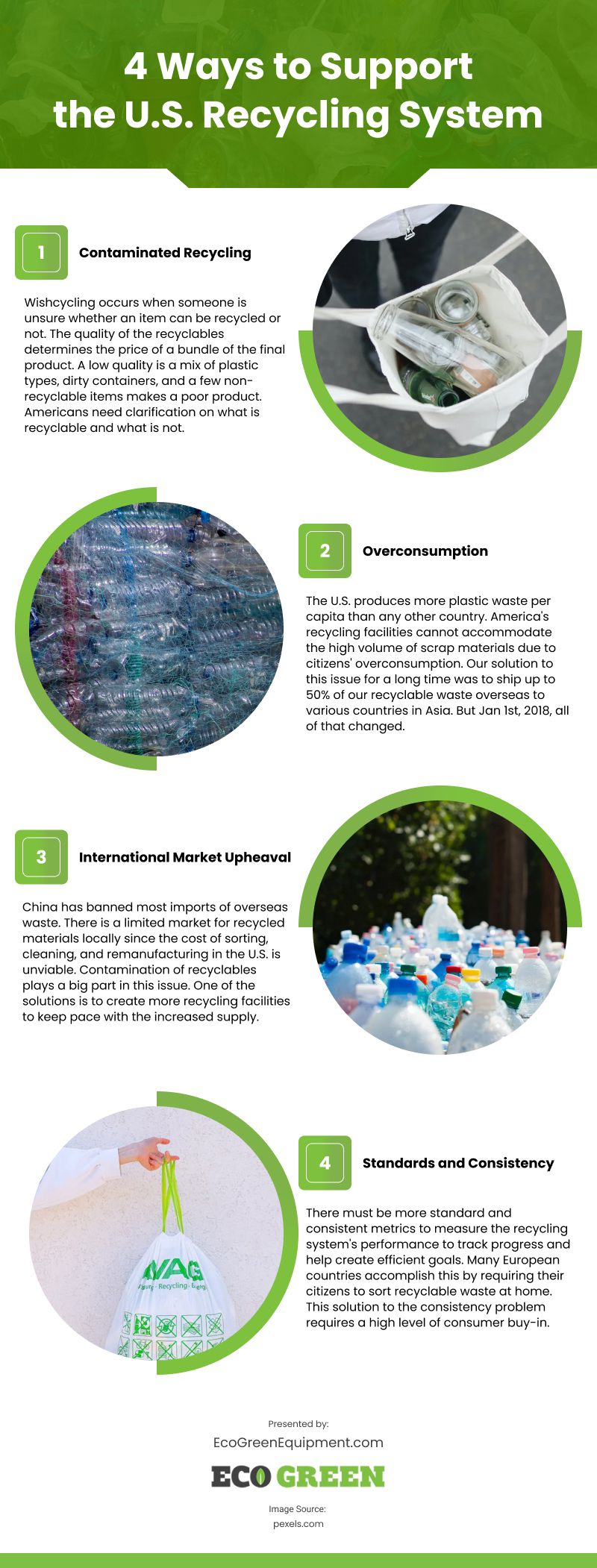Everyone understands the concept of recycling. Cans, bottles, plastic, and paper are basic materials that can be collected, processed, and remanufactured into new products.
Everyone understands the benefits of recycling. It keeps trash out of landfills and helps preserve the environment from harmful chemicals and reduces our need to harvest precious resources. It even creates jobs.
Regardless of whether everyone takes the time to do it, everyone understands how to recycle. Keep different collection bins. Put recyclables in one, and put non-recyclables in the other. The blue bin gets picked up on Monday, and the green one on Wednesday. Easy as that.
What everyone doesn’t understand is how the big-picture recycling system works in the United States, the failings of the current system, and the ways we can improve it.
There are four main obstacles to the current national recycling system. All of these barriers can be tackled in some way by individuals.
Obstacle 1: Contaminated Recycling
Wishful recycling, aka wishcycling, is well-intentioned yet leads to one of the most significant challenges to the recycling industry. Wishcycling occurs when someone is unsure whether an item can be recycled or not. In the hopes that it can be, they place it into their recycling.
Why is this a problem? The quality of the recyclables determines the price of a bundle of the final product. Take plastics for example. A low quality is a mix of plastic types, dirty containers, and a few non-recyclable items makes a poor product. If too contaminated, processors will discard the entire bundle to a landfill. Wishful recycling, rather than increasing the number of recycled items, actually has the opposite effect. Americans need clarification on what is recyclable and what is not.
Many items you might think cannot be recycled, like batteries and tires, can be recycled but not through the municipal collection system. You can, for example, take your tires to a tire recycling line. Tire shredders will process them into rubber mulch.
Obstacle 2: Overconsumption
America’s recycling facilities cannot accommodate the high volume of scrap materials due to the citizens’ overconsumption. The truth is the U.S. produces more plastic waste per capita than any other country. While China and others create more plastic for first-time use, we’re throwing it into the garbage.
There are simple ways to reduce overconsumption:
- Use reusable water bottles, coffee cups, straws, etc.
- Consider the packaging of food, toys, clothing, and accessories you purchase
- Avoid fast food
- Talk to friends about consumer culture
- Spend on experiences, not things
The equation is simple. We create more waste than our recycling facilities can sort through, process, and remanufacture. Our solution to this issue for a long time was to ship up to 50% of our recyclable waste overseas to various countries in Asia. But Jan 1st, 2018, all of that changed.
Obstacle 3: International Market Upheaval
On Jan 1st, 2018, China banned most imports of overseas waste. Unfortunately, there is a limited market for recycled materials locally since the cost of sorting, cleaning, and remanufacturing in the U.S. is unviable. When the costs outweigh the gains, the market crashes. A commodity must be rare to be valuable. Waste that needs recycling is not rare. Contamination of recyclables plays a big part in this issue.
One of the solutions is to create more recycling facilities to keep pace with the increased supply. While the economics are disappointing for some kinds of recycling, like contaminated plastic waste, more niche recycling companies can still thrive. A willing entrepreneur can purchase tire recycling equipment and create a tire recycling facility at a relatively low cost compared to many other business ventures.
Obstacle 4: Standards and Consistency
There must be more standard and consistent metrics to measure the recycling system’s performance to track progress and help create efficient goals. Many European countries accomplish this by requiring their citizens to sort recyclable waste at home. There will be four or five containers for glass, paper, hard plastics, and cans rather than one recycling bin. This solution to the consistency problem requires a high level of consumer buy-in.
How can you help?
The number one action you can take is to learn what items can and can’t be recycled so that you no longer contribute to contaminated waste by wishcycling.
How important is it really? Are things I put in the recycling bin actually recycled? How can I reduce my plastic waste consumption? Diving into these questions and spreading the information to friends can help shift the culture of poor recycling and overconsumption in America.
Recycling benefits are very apparent. However, at the current moment, it’s not a happily ever after story. In 2021, the EPA stated that only 8.7% of plastic was recycled. That means more than nine out of ten times you use plastic, it ends up in a landfill or elsewhere in the environment. Yet, changes to the system and consumer habits might make recycling viable again. In the end, it requires efforts and cooperation from stakeholders and communities to beat the system’s obstacles.
Infographic
Everyone is sentient about how to recycle, regardless of whether they spend the time to do so. Utterly undiscovered to the public are the inadequacies of the existing scheme, the ways in which it might be improved, and how the US’s overall recycling system functions. The present national recycling technique is now facing four major challenges. Each of these hurdles can be overcome by an individual in some way.

Video





